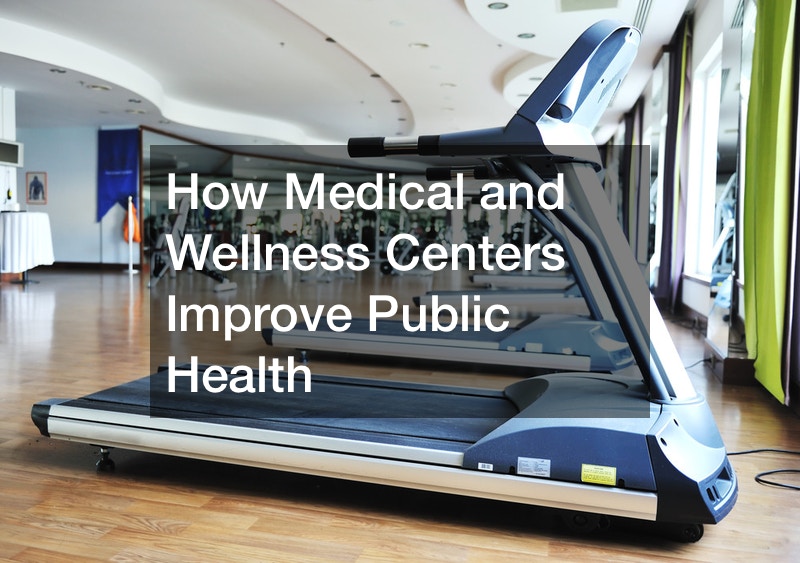
How Medical and Wellness Centers Improve Public Health

Medical and wellness centers have been in existence for a long time. Through wellness programs, people are getting more aware of their health and well-being. These programs have, to a large extent, helped change and improve the public health sector. Medical and wellness centers have also helped patients better their lives and make their communities enjoyable. In the public health sector, here is how wellness centers have been beneficial.
Improved Employee Health Behaviors
Behavior change is the core of every productive wellness program. In the public health sector, behavior change among employees is necessary. This is because patients and the community depend on the services provided by the healthcare professional, especially when seeking medical attention. The public health sector should have employees with improved health behaviors. With the availability of medical and wellness programs, healthcare providers now have an effective platform to address their behaviors and maintain their focus on service delivery. Employees in the public health sector can now gain the right education, get social support, develop skills, and gain motivation through wellness programs.
You should note that when public health employees improve their health behaviors, both the patients and communities benefit. Through the programs in a health and wellness center, the healthcare providers also lower the chances of health risks that would otherwise make it hard to be helpful and productive in the community. You should also note that wellness programs help healthcare providers adopt and maintain healthy and meaningful behaviors. When employees engage in or participate in good wellness programs, maintaining healthy behaviors for years to come becomes easier. Having a focused and committed workforce in public health sectors is paramount to everyone.

Reduced Elevated Health Risks
Apart from adopting health behaviors, public health workers need to pay attention to healthy nutrition. Like other patients, healthcare providers are also at risk of developing health complications. However, the availability of wellness centers creates an avenue for healthcare providers to utilize in taking care of their wellbeing. It also becomes easier for these professionals to preach the relevance of good health to their patients and the communities when they practice the talk. Wellness centers have improved public health as both the patients and the medical professionals can benefit from their existence.
Through medical and wellness programs, people can now improve their nutrition and physical activities and reduce elevated health risks in the process. When people, including healthcare providers, experience lower health risks, the public health sector remains productive. It is easier to convince and encourage people to change their diet and get active when the results for public health are significant. Apart from the change in diet and nutrition, wellness programs help patients and the community understand the essence of medical checkups. People can now go for adult eye evaluation and related checkups, making it possible to reduce elevated health risks.
Wellness Programs Help Reduce Healthcare Costs
People engage in lifestyles that become costly in the long run. As much as wellness programs represent physical and mental transformation, they also help reduce healthcare costs to a larger extent. When people embrace positive living and healthy habits, they also lower the chances of developing health complications. Most health complications and illnesses call for expensive quality medical care that many people find hard to afford. Most wellness programs aim at addressing preventive measures that people can utilize and reduce the chances of developing health issues.
The financial impacts of wellness programs on public health are positive. When employees in the public health sector embrace healthy behaviors, they also increase their productivity. This means they have a high service delivery rate and increases the revenues in their respective healthcare facilities. With increased revenues comes more development within the public health sector. Wellness centers have also been beneficial in providing cost-effective services to patients and communities, reducing the dependence on public health facilities. People can now access cost-effective services such as arthritis treatment and other related medical needs through wellness programs, increasing quality medical care service delivery in the hospitals and the communities.

Improved Emotional Health Among Patients
In medical and wellness centers, most programs and activities that people engage in aim at physical and emotional wellness. It is easier for patients to gain emotional stability when they enroll in a wellness facility. The availability of healthcare professionals in these facilities makes it possible for patients and community members to access public health, increasing their chances of handling their emotional needs. With improved emotional health among patients, making informed decisions about their medical needs becomes easier. Through wellness programs, there is a reduction in depression and anxiety among patients.
The public health sector benefits from wellness programs as they have an avenue where patients can get guidance on mental health issues and other underlying disorders. Patients also get engaged in activities that help alleviate back pain, making concentrating on related treatment easier. Through massages and relaxation techniques, patients can take care of their physical and mental health with ease. Most public health facilities also work with professionals in most wellness centers in the provision of healthcare services. Medical and healthcare practitioners can also depend on wellness centers to get guidance on how to improve their emotional and mental health.
Helps in Alleviating Chronic Pain Among Patients
Most people consult wellness centers to understand ways of reducing or alleviating chronic pain. Managing chronic pain is complex and can include different medications and complementary therapies. As much as people seek public health services, wellness programs become vital when it comes to chronic pain. Public health facilities can depend on wellness centers to help their patients manage and get through chronic pain. Most people who seek and engage in wellness programs get individualized care, making it possible to manage the pain and focus on recovery. There are also intravenous therapies in wellness centers giving patients a chance to handle and go through any condition.
Wellness programs improve public health as medical care practitioners utilize massage techniques and passive movements that they learn in wellness facilities when treating their patients. It is now possible for people to visit and seek care and attention from public health facilities to get the needed services. It is also possible for patients to access mobility aids when they visit wellness centers, improving public health in the process. This is vital as people trying to manage chronic pain can get assistance from public health facilities and wellness centers.

Wellness Centers Offer Non-invasive Aesthetic Treatments
People seeking aesthetic treatment services will consider safe alternatives. Everyone seeks an opportunity to manage wrinkles, reduce skin blemishes, and prevent aging without experiencing pain. While some aesthetic treatment services can be painful, wellness programs offer safe alternatives. In wellness centers, patients get non-invasive aesthetic treatments that guarantee satisfactory risk-free changes, making it easier for people to meet their objectives. The techniques used in these medical and wellness centers are what public health facilities utilize in providing care and attention needed by their patients. The applicability of these techniques when providing non-invasive aesthetic treatment makes public health attractive to patients and communities.
Apart from non-invasive aesthetic treatments, wellness centers have also been helpful in public health by introducing alternative medicine that patients can use. Public health facilities can now incorporate medical treatment with wellness programs and activities to achieve their objectives. Most wellness centers also engage in medical research and develop new forms of treatment that public health facilities can utilize. People can now get individualized treatment and care from wellness centers as a result of intensive research done. You should note that both the young and the old can access public health services from reputable medical and wellness centers.
Wellness Centers Offer Lifelong Learning Courses
There are always new things to learn every day when it comes to providing proper public health services in the community. Apart from healthcare providers, community members can also learn new things about how to take care of and improve their health. Medical and wellness centers also form the best avenue for patients and healthcare providers to learn and develop effective skills. People can explore new interests and develop new skills in the wellness centers and improve public health in the process. Most of these facilities have professionals and specialties that provide awareness and guidance on public health to patients and communities.
You should note that most of these lessons are lifelong and helpful. This means that patients who benefited from the lessons can pass the knowledge to their younger ones. It is crucial to understand that the lifelong learning courses range from basic health care lessons to complex courses such as neurological rehabilitation. Patients and healthcare providers in the public health sector can now understand the world around them and care for themselves and others. Through the lessons learned in wellness centers, it is now possible for people to improve public health and enhance their quality of life. Medical and wellness centers are also sources of information that medical facilities and people in the communities can depend on.
Fitness Programs
Most people enroll in wellness centers to utilize the fitness programs available. Fitness programs are vital to patients who seek to achieve full recovery with ease. Unlike public gyms, wellness centers offer targeted fitness programs. These programs aim to engage patients in physical activities that keep them fit despite their medical condition. The fitness programs available in most wellness centers also help improve public health by creating the right platform for everyone, including healthcare providers, to use. Through exercises and other fitness activities, patients can address health conditions such as heart problems and undergo cardiopulmonary rehabilitation to achieve recovery with ease.
Fitness programs offered in wellness centers improve public health as there are professionals who guide people through exercises. It is also possible for patients to undergo individualized fitness sessions to address specific conditions. With the availability of trained fitness instructors to provide guidance, you get the most from the fitness programs easily. Apart from providing help to patients, wellness centers also provide an effective avenue for healthcare providers to keep fit and focus on providing quality medical services to the community.

Improved Productivity Among Healthcare Providers
Medical and wellness centers are a source of motivation and encouragement for healthcare providers. Through the fitness and empowerment programs present in wellness centers, healthcare providers have a platform that helps them stay active and productive. There are also social activities that medical professionals can engage in to improve their interaction. When they engage in such activities, they also improve their collective consciousness as professionals. They find it easy to talk about different aspects of life as they engage in fitness activities in the wellness center.
An active and motivated healthcare workforce has become vital in the public health sector. This is because of the increased concentration levels among the healthcare providers that make them provide quality care and attention to their patients. With wellness programs, healthcare providers can avoid unhealthy lifestyle choices that might affect them and their productivity. They avoid unhealthy behaviors that would make them end up in a foot doctors office due to injuries sustained from accidents at work. You should note that having a productive workforce of healthcare providers in the community is beneficial to everyone.
Improved Employee Recruitment and Retention
Medical and wellness centers have gradually improved public health in the communities as most medical facilities can now recruit and retain productive employees. This is because of the lifelong lessons and research that most wellness centers engage in. Healthcare providers can also undergo training to gain relevant skills through wellness programs. Healthcare facilities can also depend on wellness centers to find skilled and experienced professionals to join their workforce. Through training and empowerment programs available in wellness centers, employers can now hire and retain the best professionals, improving public health in the process.
Apart from recruiting and retaining productive healthcare providers, the community can also utilize other services provided by these professionals. Patients and the communities can access mobile lab services, improving public health even in remote areas. When the medical services are available, handling medical and healthcare issues people suffer from becomes easier.
The benefits of wellness are overwhelming for both the patients and the community. It is possible to improve the patients’ health, the healthcare providers’ wellbeing, and public health through the wellness programs present. Improved public health is vital to society, and understanding how wellness centers help achieve this becomes paramount. Through the various activities and services provided in medical and wellness centers, the patients, healthcare providers, medical facilities, and the communities have an avenue to improve.


